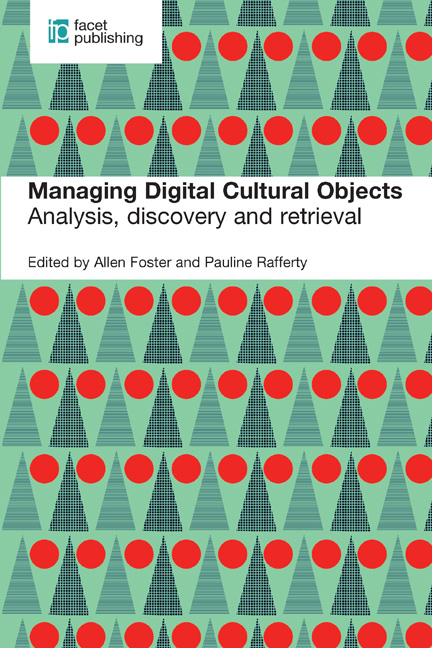Book contents
- Frontmatter
- Contents
- List of figures and tables
- Contributors
- Introduction
- PART 1 ANALYSIS AND RETRIEVAL OF DIGITAL CULTURAL OBJECTS
- PART 2 DIGITIZATION PROJECTS IN LIBRARIES, ARCHIVES AND MUSEUMS: CASE STUDIES
- PART 3 SOCIAL NETWORKING AND DIGITAL CULTURAL OBJECTS
- 7 Photos: Flickr, Facebook and other social networking sites
- 8 Searching and classifying affinities in a web music collection
- 9 Film retrieval on the web: sharing, naming, access and discovery
- Index
9 - Film retrieval on the web: sharing, naming, access and discovery
from PART 3 - SOCIAL NETWORKING AND DIGITAL CULTURAL OBJECTS
Published online by Cambridge University Press: 09 June 2018
- Frontmatter
- Contents
- List of figures and tables
- Contributors
- Introduction
- PART 1 ANALYSIS AND RETRIEVAL OF DIGITAL CULTURAL OBJECTS
- PART 2 DIGITIZATION PROJECTS IN LIBRARIES, ARCHIVES AND MUSEUMS: CASE STUDIES
- PART 3 SOCIAL NETWORKING AND DIGITAL CULTURAL OBJECTS
- 7 Photos: Flickr, Facebook and other social networking sites
- 8 Searching and classifying affinities in a web music collection
- 9 Film retrieval on the web: sharing, naming, access and discovery
- Index
Summary
Introduction
Non-textual resources can prove to be elusive targets on the web. Searching for a specific film or video often requires both fortitude and perseverance because of the multi-layered complexity of these resources. According to Turner (2009), moving image materials are ill-served by the prevalent systems of organization designed for print materials. Neal (2012, 5) quoting from the arguments of O'Connor and Wyatt (2004) notes, ‘words are not pictures and vice versa’. Far too often, the experience of searching for moving images is strikingly similar to the plot of All Is Lost (Chandor et al., 2013), starring Robert Redford. Featuring a solitary and nearly silent protagonist facing a series of nightmarish and unfathomable disasters with heroic resilience, this film celebrates the triumph of the human spirit.
Providers of digital cultural objects face increasing pressure to provide seamless networked access to their collections and a growing sense of urgency to create interoperable, exchangeable metadata. Amidst this pressure, digital cultural asset managers are compelled to develop and co-ordinate standards that foster interoperability and remote access (Turner, 2009). The current landscape of web access to film and video is most often provided through surrogate representations (keywords, abstracts, etc.) in both free or subscription databases and catalogues, or directly via free or fee streaming film sites or film study portals, which often combine access with richly detailed metadata and associated content (Smeaton, 2004; Oberhelman, 2014).
Background
This chapter extends a previous study (La Barre and Cordeiro, 2012) that called for the creation of more robust access and discovery interfaces for films across a variety of digital platforms. It engages with both technical and strategic issues relating to film retrieval on the web by touching on issues such as distributed data structures, linked data and controlled and uncontrolled access points. A case study on the source of subject and authority metadata for films and the discovery and access structures for users across several different web environments – including YouTube, which enables ‘people to discover, watch and share originally-created videos’ (www.youtube/yt/about) and the Internet Movie Database (IMDb), ‘a searchable database of more than 100 million data items including more than 2 million movies’ (www.imdb.com/about) – frames our discussion.
- Type
- Chapter
- Information
- Managing Digital Cultural ObjectsAnalysis, discovery and retrieval, pp. 199 - 218Publisher: FacetPrint publication year: 2016



